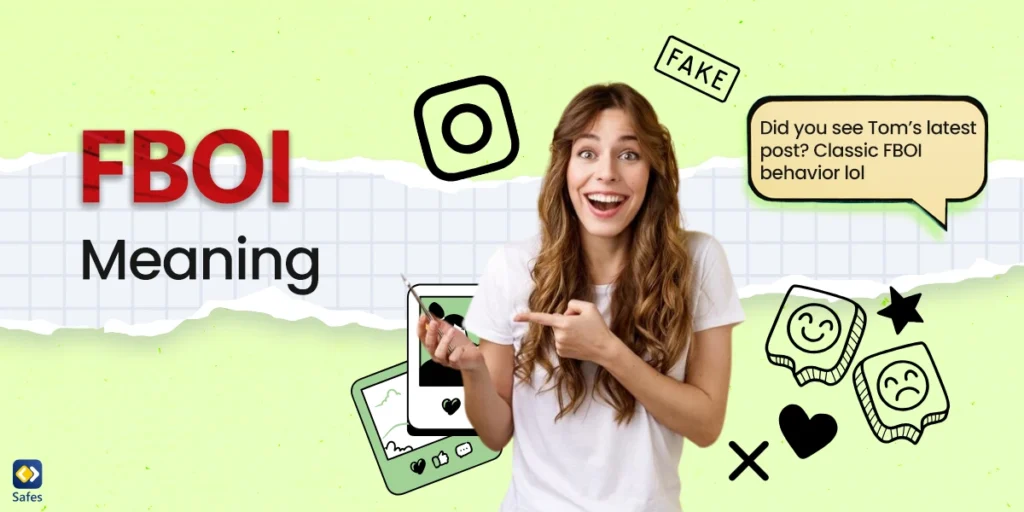In 2025, understanding the FBOI meaning has become crucial for parents navigating the ever-changing landscape of teen communication. As social media and digital interactions continue to shape how young people express themselves, staying informed about the latest slang and its implications is more important than ever. This comprehensive guide will delve into the world of FBOI, its usage, and what parents need to know to keep their children safe online.
Download and Start Your Free Trial of the Safes Parental Control App
Definition & Meaning of FBOI
FBOI, which stands for “Fake Boyfriend of Instagram,” has evolved significantly in social media culture. This term describes individuals who curate false online personas, often presenting idealized versions of themselves and engaging in superficial relationships. The FBOI phenomenon goes beyond just Instagram, extending to various social media platforms and digital communication channels.
Alternative spellings or variations of FBOI are rare, as the term is typically used in its acronym form. However, it’s worth noting that “FBOY” is a related term that often carries similar connotations.
How It’s Used in Real Digital Interactions
The FBOI meaning in chat contexts often varies, making it essential for parents to stay informed about its usage. Here are some examples of how teens might use FBOI in their digital interactions:
- Social Media Comments:
“That guy is such an FBOI, always posting fake romantic pics 🙄” - Private Messages:
“Watch out for Jake, he’s a total FBOI. Don’t fall for his act!” - Group Chats:
“Did you see Tom’s latest post? Classic FBOI behavior lol”
The tone when using FBOI is often sarcastic or critical. Teens typically use it to call out behavior they perceive as inauthentic or manipulative, especially in the context of online dating or social media interactions. It’s a way for young people to express skepticism about the curated images and personas they encounter online.

Decoding FBOI Slang: What It Really Means in 2025
Grasping the FBOI slang meaning can help parents better understand and communicate with their teens in the digital age. In 2025, FBOI has become more than just a simple acronym; it’s a concept that encapsulates a range of behaviors and attitudes prevalent in online spaces.
Key characteristics of an FBOI include:
- Excessive focus on appearance and aesthetics in social media posts
- Frequent updates showcasing an idealized lifestyle
- Superficial interactions with followers, often aimed at gaining attention
- A disconnect between online persona and real-life behavior
Understanding these nuances can help parents have more meaningful conversations with their teens about authentic self-presentation and healthy online relationships.
Platform-Specific Usage
The use of FBOI varies across different social media platforms, each with its own unique context:
- TikTok:
- Millions of views under the #FBOI hashtag
- Features comedic content mocking FBOI behavior
- Users create parody videos highlighting FBOI characteristics
- Instagram:
- Side-by-side comparisons of edited vs. unedited content
- Critique of unrealistic social media standards
- Influencer commentary on the FBOI phenomenon
- Discord:
- Dedicated servers for discussing FBOI experiences
- Support groups for those affected by FBOI behavior
- Meme sharing and coping mechanisms related to FBOI encounters
- Snapchat:
- Quick, disappearing messages calling out FBOI behavior
- Filters and lenses parodying typical FBOI aesthetics
- Gaming Chats:
- Used to describe players who present a false persona in gaming communities
- Often associated with players who exaggerate their skills or achievements
As of 2025, the term is particularly trending on TikTok and Instagram, where visual content and personal branding are central to user interactions.
Risk Level Indicator (Parent Alert System)
🟡 Yellow – Context matters; can be misused.
The use of FBOI in teen communication falls into the yellow category of our risk level indicator. While the term itself is not inherently harmful, its context and implications can lead to potential issues:
- Cyberbullying: The term could be used to mock or shame individuals, leading to emotional distress.
- Self-esteem Issues: Constant exposure to “FBOI culture” might negatively impact teens’ self-image and confidence.
- Trust Problems: Overuse of the term might lead to excessive skepticism in online interactions, making it difficult for teens to form genuine connections.
Parents should be aware that while FBOI is often used humorously, it can also reflect and perpetuate unhealthy attitudes towards online relationships and self-presentation.
Trend Tracker: Is It Still Relevant?
🔥 Trending (widely used now)
As of July 2025, FBOI remains a highly relevant and widely used term in teen digital communication. Its popularity has grown steadily over the past few years, reflecting broader trends in social media usage and online behavior.
Key factors contributing to its continued relevance:
- Increased awareness of social media’s impact on mental health
- Growing skepticism towards influencer culture
- Gen Z’s emphasis on authenticity in digital spaces
While some slang terms quickly fade into obscurity, FBOI has shown staying power due to its applicability across various platforms and its role in critiquing certain aspects of online culture.
Mini Case Study: The FBOI Challenge
In early 2025, a trend known as the “FBOI Challenge” went viral on TikTok, accumulating over 500 million views in just two weeks. The challenge involved users creating before-and-after videos, contrasting their “FBOI persona” with their authentic selves.
Example:
@realme2025 posted a video that started with a highly edited, glamorous self-portrait captioned “FBOI me 🤳✨” followed by a casual, unfiltered clip captioned “Real me 😊🌿”. The video garnered 10 million likes and sparked conversations about authenticity online.
This trend highlighted the widespread understanding of FBOI culture among teens and young adults, while also promoting a move towards more genuine self-presentation on social media platforms.
Online Safety Considerations
As internet slang meaning continues to evolve, terms like FBOI represent a new frontier in online expression. However, they also bring potential risks that parents should be aware of:
- Deceptive Online Personas: The FBOI concept is closely tied to the creation of false or exaggerated online identities. This can make it difficult for teens to discern genuine interactions from manipulative ones.
- Pressure to Conform: The prevalence of FBOI culture might pressure some teens to create unrealistic online personas themselves, leading to stress and identity issues.
- Cyberbullying: The term could be used as a form of ridicule or bullying, targeting individuals perceived as inauthentic or attention-seeking.
- Privacy Concerns: In attempting to call out FBOI behavior, teens might share personal information or images without considering the long-term consequences.
Quick advice for parents:
- Open Communication: Regularly discuss online experiences with your teens, including their encounters with FBOI behavior.
- Media Literacy: Help your children develop critical thinking skills to navigate and interpret online content.
- Promote Authenticity: Encourage your teens to be genuine in their online interactions and to value authenticity in others.
- Monitor Without Invading Privacy: Use parental control apps to keep an eye on your child’s online activities while respecting their privacy.
- Lead by Example: Demonstrate healthy social media habits in your own online presence.
Safeguarding Your Teens Online
As we’ve explored the complexities of FBOI and its impact on teen communication, it’s clear that staying informed and proactive is key to ensuring your child’s online safety. This is where parental control apps can play a crucial role in monitoring and guiding your teen’s digital interactions.
Introducing Safes, a comprehensive parental control app designed to help parents navigate the challenges of raising children in the digital age. Safes offers a range of features that can assist you in keeping your children safe online:
- Real-time monitoring of social media activity
- Content filtering to block inappropriate websites and apps
- Screen time management tools
- Location tracking for peace of mind
- Detailed reports on your child’s online behavior
With Safes, you can stay informed about your teen’s exposure to trends like FBOI while respecting their privacy and independence. The app provides a balanced approach to digital parenting, allowing you to protect your children without overly restricting their online experiences.
We encourage you to take the first step in enhancing your family’s online safety. Try Safes today with our free trial, available for both Android and iOS devices. Download now and gain the tools you need to confidently guide your children through the complex world of digital communication.
Remember, open dialogue and mutual trust are the foundations of healthy digital habits. Use Safes as a tool to facilitate conversations about online safety, including topics like FBOI, and work together with your teens to create a positive digital environment for your family.
Your Child’s Online Safety Starts Here
Every parent today needs a solution to manage screen time and keep their child safe online.
Without the right tools, digital risks and excessive screen time can impact children's well-being. Safes helps parents set healthy boundaries, monitor activity, and protect kids from online dangers—all with an easy-to-use app.
Take control of your child’s digital world. Learn more about Safes or download the app to start your free trial today!




